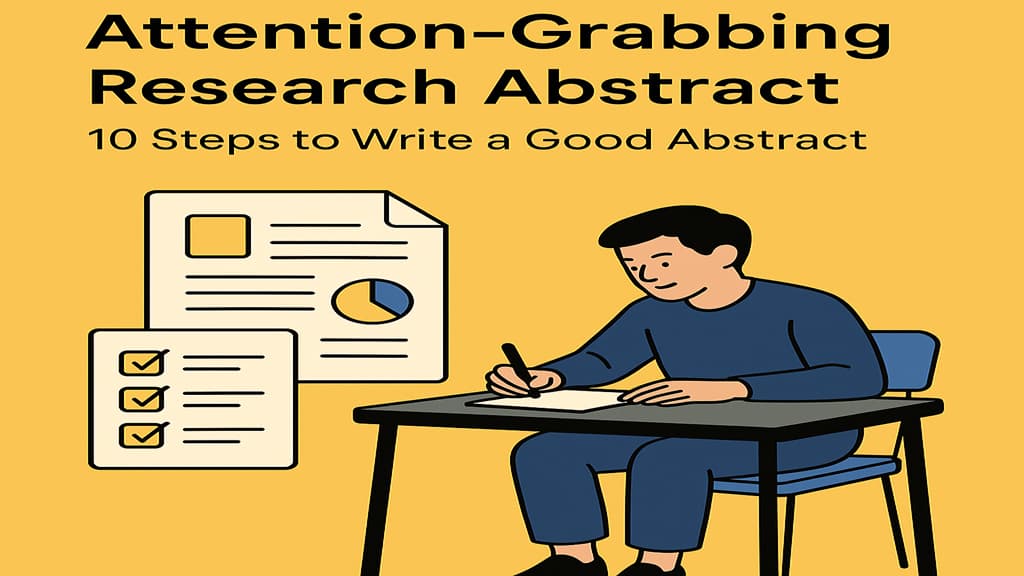How to write Attention Grabbing Research Abstract: - A research abstract is a short summary that tells readers what your paper is about. It appears at the start of academic articles and is often the first thing people read. That’s why it needs to be both clear and engaging.
But writing a strong abstract can be challenging. In this guide, we’ll show you how to write attention grabbing research abstract that clearly explains your study and captures interest right away. Whether you're a student, new researcher, or preparing to publish, this post covers everything you need to know.
What is Research Abstract?
A research abstract is a short paragraph usually 150 to 250 words that sums up your study. It should cover the topic, purpose, method, main findings, and conclusion. Abstracts are used in journals, conference papers, theses and reports. A good one helps readers quickly decide if the paper is relevant to them. If you want to know how to write attention grabbing research abstract, it’s important to understand what makes a summary effective and useful.
Why Is the Research Abstract Important?
A well-written abstract can:
- Get the attention of reviewers, editors, or event organizers
- Improve your chances of publication or presentation
- Help people understand your work and why it matters
- Make your paper easier to find online
Key Parts of a Research Abstract
A strong abstract usually includes five key elements:
- Background – A short intro to the topic and why it matters
- Objective – The main purpose or research question
- Methods – How the study was done
- Results – What you found
- Conclusion – What the findings mean or why they matter
Types of Abstracts
- Descriptive Abstracts: Mention the topic and scope but don’t go into results or conclusions
- Informative Abstracts: Include purpose, method, results, and conclusion—more common in academic writing
A Simple Structure for Your Abstract
- Background:
"Climate change has affected global farming. Its specific impact on rice fields in coastal India is still unclear." - Objective:
"This study explores how rising sea levels affect rice yields in Eastern India." - Methods:
"We used data from 2010–2020 and satellite images. A regression model helped identify trends." - Results:
"Rice yield dropped 15% in ten years, closely linked to higher soil salinity." - Conclusion:
"These results suggest the need for salt-resistant crops and better irrigation systems."
Tips for Writing a Good Abstract
- Start Strong – Use an engaging opening line
- Be Brief and Focused – Stay within the word limit
- Use Clear Language – Avoid jargon if possible
- Be Specific – Give real results, not vague statements
- Avoid Repetition – Don’t repeat the title
- Skip Citations – No references in abstracts
- Use Active Voice – Makes writing sharper
- Edit and Review – Don’t settle for your first draft
- Ask for Feedback – A fresh set of eyes helps
- Follow Guidelines – Stick to the format if you’re submitting to a journal or conference
Common Mistakes to Avoid
- Giving too much background
- Using complex or unclear language
- Skipping the results section
- Using unexplained abbreviations
- Writing too generally without details
Good vs. Bad Abstracts
Bad Example: This paper is about pollution. It has some data and suggests ideas.
Why it fails: Too vague and unstructured.
Good Example: City pollution rose 25% over a decade. This paper analyzes data from five cities (2010–2020), finding traffic emissions are the main cause. Solutions include policy changes and better public transport.
Why it works: Clear, specific, and structured.
Field-Specific Focus
While the structure stays the same, emphasis can change depending on the subject:
- Sciences – Focus on methods and findings
- Social Sciences – Stress context and problem
- Humanities – Focus on argument and background
- Business/Marketing – Highlight problems, data, and solutions
Whichever your field, learning how to write an attention-grabbing research abstract tailored to your audience makes your work more effective.
Writing Abstracts for Conferences
Conference abstracts are often shorter around 200 words. To stand out:
- Highlight what’s new in your work
- Clearly state the research question
- Show what people will learn
Conclusion
Writing an abstract that grabs attention takes practice, but it’s a valuable skill. By focusing on clarity, structure, and purpose, you’ll learn exactly how to write attention grabbing research abstract that helps your work stand out. Keep this guide close, revise your drafts carefully, and always aim to make your summary as strong as your full paper.
Also Read: What is Research Data Analysis

